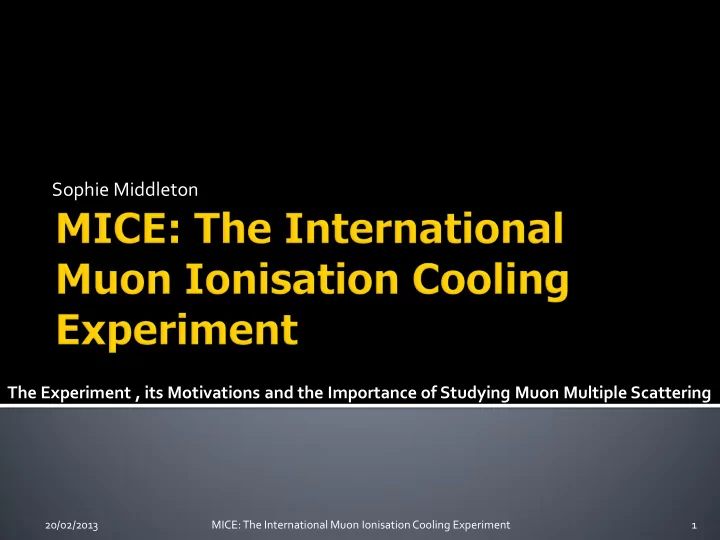

Sophie Middleton The Experiment , its Motivations and the Importance of Studying Muon Multiple Scattering 20/02/2013 MICE: The International Muon Ionisation Cooling Experiment 1
MICE: The International Muon Ionisation Cooling Experiment 20/02/2013 MICE: The International Muon Ionisation Cooling Experiment 2
Future Accelerator projects include neutrino factories and even further into the future muon colliders - both require muon acceleration Difficult due to the large transverse emittance of muon beams Only viable way to reduce emittance is through ionisation cooling MICE is a proof of principle prototype machine and aims to make the first measurements of this ionisation cooling MICE aims to observe reduction of transverse emittance of 10% for muons of momenta 140-240MeV/c 20/02/2013 MICE: The International Muon Ionisation Cooling Experiment 3
Investigate mass hierarchy and CP- violation in the lepton sector High energy protons produced: H- source and strip electrons Impact Hg target and pions produced- decay to muons Muon beam bunched and phase rotation before cooling required Muons accelerated to final energy of 10GeV Muons decay and produce neutrinos 20/02/2013 MICE: The International Muon Ionisation Cooling Experiment 4
Advantages: Would provide finely tuned, high centre of mass energy lepton collisions Unlike in hadron collider, the interaction would not be convoluted by parton distribution function Unlike e+e- colliders would not suffer from synchrotron radiation losses Require s more cooling than the neutrino factory in order to achieve high luminosity. 20/02/2013 MICE: The International Muon Ionisation Cooling Experiment 5
MICE: The International Muon Ionisation Cooling Experiment 20/02/2013 MICE: The International Muon Ionisation Cooling Experiment 6
20/02/2013 MICE: The International Muon Ionisation Cooling Experiment 7
Beam Production 1. 800MeV proton beam provided by ISIS synchrotron Titanium target dipped in beam at frequency of 1Hz - pions produced these decay in flight to muons 20/02/2013 MICE: The International Muon Ionisation Cooling Experiment 8
Absorbers and Cooling 2. Muons impact an absorber and loss energy reduces emittance Interchangeable absorbers: LH2, solid Lithium Hydride, Aluminium, Copper and Beryllium Al windows at ends of absorber module allowing entry and exit of the beam Absorber module from A. Dobbs thesis (Imperial, 2011) 20/02/2013 MICE: The International Muon Ionisation Cooling Experiment 9
3. RF Cavities The ionisation cooling will reduce emittance in all directions Need to boost the longitudinal direction MICE has 2 RFCC modules Each with 4 201MHz RF cavities and one super-conducting coil. Gradient of 8MV/m RF: A RF station with 4 cavities from A. Dobbs thesis (Imperial, 2011) 20/02/2013 MICE: The International Muon Ionisation Cooling Experiment 10
4 . Tracker Scintillating fibre trackers within 4T SC solonoid measure emittance before and after cooling Tracker has 5 30cm diameter stations each with 3 layers of 350 μ m scintillating fibre The trackers are readout by Visible Photon Light Counters (VLPCs) and are designed to measure x, y,px, py, the transverse coordinates to the beam and E the muon energy 20/02/2013 MICE: The International Muon Ionisation Cooling Experiment 11
5. Particle ID Upstream: TOF0/TOF1 calculate mass allowing the particle to be identified. Also,2 Cerenkov counters (CKOVA/CKOVB), a rate counter and 2 beam-profile monitors Downstream : TOF2 along with a KLOE- Light (KL) detector. Works with electron-muon ranger (EMR) forming downstream ECAL TOF1: 6 cm×42 cm× 2.5 cm scintillator slabs-Taken from Mark Rayner’s thesis (Oxford U.,2011) 20/02/2013 MICE: The International Muon Ionisation Cooling Experiment 12
MICE: The International Muon Ionisation Cooling Experiment 20/02/2013 MICE: The International Muon Ionisation Cooling Experiment 13
Cooling Equation: Cooling term and heating term (due to multiple scattering) Cool by passing through absorber then boost back in longitudinal direction using RF cavities 20/02/2013 MICE: The International Muon Ionisation Cooling Experiment 14
Before any measurements of cooling we need to understand heating effect i.e. multiple scattering Muons will be deflected by small angles when traversing absorber. PDG gives the expression for the RMS angle as: Where: However, recent studies from MuScat have suggested a better understanding at high scattering angles is needed 20/02/2013 MICE: The International Muon Ionisation Cooling Experiment 15
Above plots for 15.9cm LH2 (first two) and 10.9cm LH2 (end) • • Above figures show that Moliere based theories don’t successfully describe the tails of the distribution GEANT4.9.0 and ELMS better at describing this distribution at high • angles but still not great at larger angles! 20/02/2013 MICE: The International Muon Ionisation Cooling Experiment 16
W. Allison's ELMS program generates MC for thin absorbers. The method uses double differential cross sections and splits muon collisons into coulomb collisions with nuclei and electrons and collisions with the atom as a whole. The last version of the expression for scattering angle used in the 2007 analysis has a central part given by-same as in latest version of GEANT4: The tail has the functional form: Where : 20/02/2013 MICE: The International Muon Ionisation Cooling Experiment 17
Simulations again show 20% deviation from PDG-Step IV of MICE will allow direct measure of multiple scattering of muons “Multiple Scattering Measurements in the MICE Experiment” T. Carlisle, J. Cobb, Department of Physics, Oxford University, Oxford, UK Note shows that the trackers were considered able to directly measure multiple scattering in the LH2 and LiH absorbers in step IV 20/02/2013 MICE: The International Muon Ionisation Cooling Experiment 18
Scattering predictions at Z < 5 were significantly greater than measured in G4MICE Moliere predictions appear to significantly overestimate eqm emittance when compared to GEANT4 MICE simulation compared with predictions from Moliere’s theory of multiple (J. Cobb, T . Carlisle) 20/02/2013 MICE: The International Muon Ionisation Cooling Experiment 19
MICE: The International Muon Ionisation Cooling Experiment 20/02/2013 MICE: The International Muon Ionisation Cooling Experiment 20
Current Schedule: For the first year or so of my PhD I will be making further studies of multiple scattering using simulation and in 2014 (summer) will start analysing data from Step IV. 20/02/2013 MICE: The International Muon Ionisation Cooling Experiment 21
Recommend
More recommend